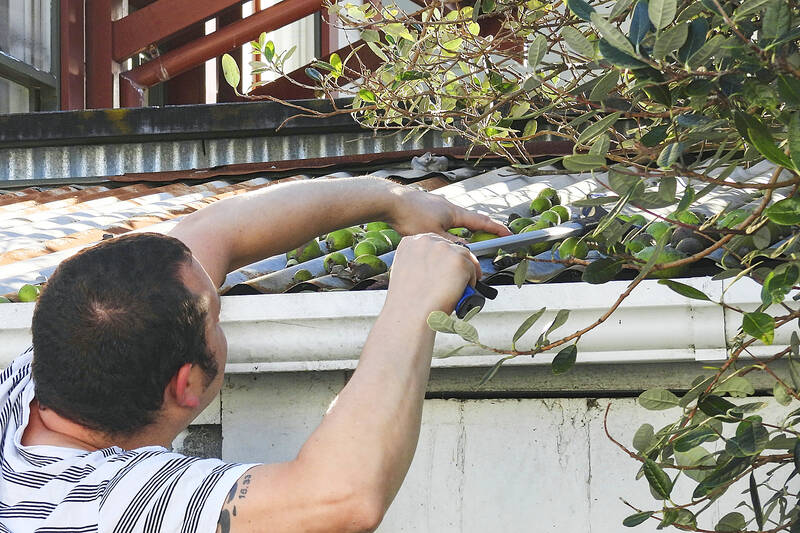The unofficial national fruit of New Zealand is not native to the country — it is South American. It is not exclusively found in New Zealand. And it is not, perhaps surprisingly, the kiwifruit. It is the feijoa.
Known as pineapple guava elsewhere, the fruit — a green perfumed oval with a polarizing taste — can be purchased in California or Canberra. Yet no country has embraced the feijoa with quite the fervor or the fixation of New Zealanders.
Due to its short shelf life, New Zealand — a nation of thriving fruit exports — has never been able to spin the feijoa into a global brand, as growers have done with apples and kiwifruit.

Photo: AP
However, during the brief span of weeks each year when the fruit is ripe, the country goes feijoa wild.
The feijoa’s allure comes partly from how it is acquired. In autumn, fallen fruit forms fragrant carpets beneath backyard trees and is swept into boxes, bags and buckets to be offered for free outside homes, in office breakrooms and on neighborhood Facebook groups. There is such abundance that some feijoa lovers take pride in never having paid for one.
“It’s sort of noncommercialized. We turn up our noses at the idea of buying them in the shop,” said Kate Evans, author of the book Feijoa: A Story of Obsession and Belonging. “You just sort of expect to get them for free.”

Photo: AP
In suburban Wellington, Diana Ward-Pickering said she had given away “thousands” of feijoas from her five backyard trees this season: in a box on the sidewalk, to neighbors, to coworkers, to her daughter’s eyelash technician — in short, to any friend or stranger who wanted some.
On a recent Sunday, Ward-Pickering selected a feijoa from dozens on the ground, halved it with a spoon and scooped the pale, creamy flesh into her mouth.
“Delicious,” she said.
However, while she could eat 1kg of the fruit in a sitting, she said, even her appetite could not keep up with the sudden and generous bounty that arrives each April.
“There are people who can’t afford to pay for them,” Ward-Pickering said. “We happily give them away.”
Not everyone is an enthusiast and every New Zealander has an opinion. What devotees of the fruit savor as a distinctive texture, flavor and smell, is gritty, soapy or sour to others.
Ward-Pickering’s daughter, Lizzy, gingerly slurped a piece of feijoa into her mouth and grimaced.
“It’s giving snot,” she said. “My mind has not changed.”
For New Zealanders abroad who love the fruit, feijoas are a nostalgic taste evocative of a Kiwi childhood.
Evans, who said that she once paid A$3 (US$1.90) for a single feijoa at a market in Australia, said that in 12 years living overseas she often saw expatriates asking the same question online: Where can I find feijoas?
How a fruit that hails from the Brazilian highlands, Uruguay and a corner of Argentina first came to New Zealand remains something of a mystery, Evans said.
However, what is known is that feijoas have been in New Zealand for just over 100 years, probably originating from California, via Australia.
The trees grow “extremely well” in New Zealand, growers say, due to the soil, subtropical climate and relative lack of destructive insect species.
In spite of New Zealand’s booming backyard feijoa economy, there is still demand for them in stores, where they are sold for about NZ$9 to NZ$10 (US$5 to US$6) per kilogram. There are about 100 commercial feijoa growers in New Zealand almost solely supplying the domestic market, including for popular beverages such as feijoa cider, kombucha and juice.
However, exporting the fruit is “tricky,” said Brent Fuller, spokesperson for the New Zealand Feijoa Growers Association. “They’ll keep in the chiller for two or three weeks, but that’s about it.”
Research is under way to increase the shelf life of the fruit, but with the name feijoa still unknown abroad, it remains for now an institution of New Zealand’s autumn.
“It’s something that kind of bonds us and gives us an excuse to talk to people around us,” Evans said.
The kiwifruit has been a lucrative export for New Zealand, “but we don’t love it the way that we love feijoas,” she added.

REVENGE: Trump said he had the support of the Syrian government for the strikes, which took place in response to an Islamic State attack on US soldiers last week The US launched large-scale airstrikes on more than 70 targets across Syria, the Pentagon said on Friday, fulfilling US President Donald Trump’s vow to strike back after the killing of two US soldiers. “This is not the beginning of a war — it is a declaration of vengeance,” US Secretary of Defense Pete Hegseth wrote on social media. “Today, we hunted and we killed our enemies. Lots of them. And we will continue.” The US Central Command said that fighter jets, attack helicopters and artillery targeted ISIS infrastructure and weapon sites. “All terrorists who are evil enough to attack Americans are hereby warned

‘POLITICAL LOYALTY’: The move breaks with decades of precedent among US administrations, which have tended to leave career ambassadors in their posts US President Donald Trump’s administration has ordered dozens of US ambassadors to step down, people familiar with the matter said, a precedent-breaking recall that would leave embassies abroad without US Senate-confirmed leadership. The envoys, career diplomats who were almost all named to their jobs under former US president Joe Biden, were told over the phone in the past few days they needed to depart in the next few weeks, the people said. They would not be fired, but finding new roles would be a challenge given that many are far along in their careers and opportunities for senior diplomats can

Seven wild Asiatic elephants were killed and a calf was injured when a high-speed passenger train collided with a herd crossing the tracks in India’s northeastern state of Assam early yesterday, local authorities said. The train driver spotted the herd of about 100 elephants and used the emergency brakes, but the train still hit some of the animals, Indian Railways spokesman Kapinjal Kishore Sharma told reporters. Five train coaches and the engine derailed following the impact, but there were no human casualties, Sharma said. Veterinarians carried out autopsies on the dead elephants, which were to be buried later in the day. The accident site

RUSHED: The US pushed for the October deal to be ready for a ceremony with Trump, but sometimes it takes time to create an agreement that can hold, a Thai official said Defense officials from Thailand and Cambodia are to meet tomorrow to discuss the possibility of resuming a ceasefire between the two countries, Thailand’s top diplomat said yesterday, as border fighting entered a third week. A ceasefire agreement in October was rushed to ensure it could be witnessed by US President Donald Trump and lacked sufficient details to ensure the deal to end the armed conflict would hold, Thai Minister of Foreign Affairs Sihasak Phuangketkeow said after an ASEAN foreign ministers’ meeting in Kuala Lumpur. The two countries agreed to hold talks using their General Border Committee, an established bilateral mechanism, with Thailand